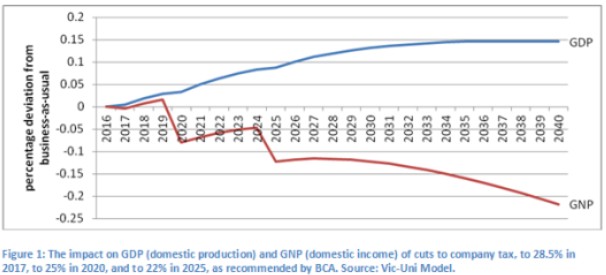In a scene reminiscent of the 1990’s hit, “The Castle”, Treasurer Scott Morrison has effectively told us to ignore modelling on the Coalition’s company tax cut plan and instead go with ‘the vibe’. From The ABC:
Federal Treasurer Scott Morrison has declined to detail the economic modelling of his Government’s company tax cuts because he says it does not matter to people in the pub.
When pressed, Scott Morrison and his office could not provide any economic modelling for the package that passed the Senate on Friday.
“If you go down to the pub and talk to small business people, they’re not talking about econometric models,” he said.
“The Government doesn’t need to be convinced about the need to give small and medium-sized businesses a tax cut.
“The Turnbull Government knows how business works, we focus on the things we know make a difference because of our life experience and our background in business”…
$50 billion refers to the cost of the Government’s full tax cut package, which did not pass the Senate.
Mr Morrison says the Government remains committed to that package, which involves cutting the tax rate to 25 per cent for all businesses over the next decade.
The Senate has so far refused to support it, but it is the only package the Government has commissioned economic modelling for.
“Our modelling was done on the entire tax package,” he said.“[The entire package] lifts the GDP by 1 per cent permanently.
“We remain committed to the entire package and our modelling is done on the entire package.”
It’s probably best that we don’t look at Treasury’s company tax cut modelling, because it is far from flattering and showed almost zero impact on ‘jobs and growth’ despite its estimated $8.2 billion dollar cost per year. As explained by The Australia Institute’s Richard Denniss:
According to Treasury’s in-house modelling, and the modelling it commissioned from Chris Murphy, if the company tax rate is lowered from 30 per cent to 25 per cent then gross domestic product will double by September 2038, while without the tax cut it won’t double until December 2038. Wow, a whole three months earlier. Both modelling exercises conclude that in 20 years’ time the unemployment rate will be 5 per cent regardless of whether we spend $50 billion on company tax cuts or not…
The “benefits” are more accurately described as rounding error than significant reform.
Separate modelling from Victoria University senior research fellow, Janine Dixon, found that cutting the company tax rate would actually lower national income (GNP) and living standards because of the benefits flowing offshore:

The only good thing that can be said about the package passed by the Senate is that it limits the damage to the Budget. Because the turnover threshold has been capped at $50 million, the package primarily captures Australian-owned companies that are subject to Australia’s dividend imputation system. Thus, revenue losses to the Budget will be offset to a large extent by a commensurate reduction in franking credits.
The fact that the Turnbull Government has remained committed to passing the full company tax cut package in the future – despite its huge cost, immaterial economic benefits, and general unpopularity within the electorate – shows that it has a shocking tin ear. It should dump the plan and move on while it can.

